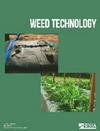Pink Purslane (Portulaca pilosa) Control with Postemergence Herbicides
IF 1.3
3区 农林科学
Q3 AGRONOMY
引用次数: 0
Abstract
Pink purslane is often ranked as one of the most troublesome weeds in vegetable production systems in Georgia. Pink purslane encroachment along the field edges and in-field of agronomic crops has recently increased. Postemergence (POST) herbicides are an effective component of agronomic crop weed management. However, little research has addressed pink purslane control in agronomic crops. Therefore, greenhouse and field studies were conducted from 2022 to 2023 in Tifton, Georgia, to evaluate the response of pink purslane to POST herbicides commonly used in agronomic crops. Greenhouse screening provided preliminary evidence whereby 13 of the 21 POST herbicides evaluated provided ≥ 80% above-ground biomass reductions. These 13 herbicides were then used for field studies. Results from the field studies, pooled across two locations, indicated only 3 of the 13 herbicides provided above-ground biomass reductions ≥ 70% compared to the non-treated control. These herbicides included atrazine at 1682 g ai ha-1, glufosinate at 656 g ai ha-1, and lactofen at 219 g ai ha-1 with 79%, 70%, and 83% biomass reduction, respectively (P < 0.05). This research suggests that many of the POST herbicides used in agronomic crops will not effectively control pink purslane. Thus, when trying to manage pink purslane with POST herbicides in agronomic crops, growers should plant crops/cultivars tolerant of either atrazine, glufosinate, and/or lactofen.用苗后除草剂控制粉红马齿苋(马齿苋
粉红马齿苋通常被列为佐治亚州蔬菜生产系统中最棘手的杂草之一。最近,粉红马齿苋在田边和农艺作物田间的侵扰有所增加。萌发后(POST)除草剂是农作物杂草管理的有效组成部分。然而,很少有研究涉及粉红马齿苋在农作物中的防治。因此,我们于 2022 年至 2023 年在佐治亚州蒂夫顿开展了温室和田间研究,以评估粉红马齿苋对农作物常用的苗后除草剂的反应。温室筛选提供的初步证据表明,在 21 种经评估的后效除草剂中,有 13 种可减少≥ 80% 的地上生物量。这 13 种除草剂随后被用于田间研究。两个地点的实地研究结果表明,与未处理的对照组相比,13 种除草剂中只有 3 种能使地上生物量减少 ≥ 70%。这些除草剂包括剂量为 1682 g ai ha-1 的阿特拉津、剂量为 656 g ai ha-1 的草铵膦和剂量为 219 g ai ha-1 的乳氟禾草灵,其生物量减少率分别为 79%、70% 和 83%(P < 0.05)。这项研究表明,许多用于农作物的后效除草剂不能有效控制粉红马齿苋。因此,在尝试使用农艺作物中的后效除草剂控制粉红马齿苋时,种植者应种植耐受阿特拉津、草胺膦和/或乳油的作物/栽培品种。
本文章由计算机程序翻译,如有差异,请以英文原文为准。
求助全文
约1分钟内获得全文
求助全文
来源期刊

Weed Technology
农林科学-农艺学
CiteScore
2.90
自引率
21.40%
发文量
89
审稿时长
12-24 weeks
期刊介绍:
Weed Technology publishes original research and scholarship in the form of peer-reviewed articles focused on understanding how weeds are managed.
The journal focuses on:
- Applied aspects concerning the management of weeds in agricultural systems
- Herbicides used to manage undesired vegetation, weed biology and control
- Weed/crop management systems
- Reports of new weed problems
-New technologies for weed management and special articles emphasizing technology transfer to improve weed control
-Articles dealing with plant growth regulators and management of undesired plant growth may also be accepted, provided there is clear relevance to weed science technology, e.g., turfgrass or woody plant management along rights-of-way, vegetation management in forest, aquatic, or other non-crop situations.
-Surveys, education, and extension topics related to weeds will also be considered
 求助内容:
求助内容: 应助结果提醒方式:
应助结果提醒方式:


